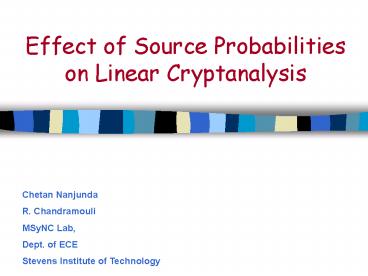Effect of Source Probabilities on Linear Cryptanalysis - PowerPoint PPT Presentation
1 / 9
Title:
Effect of Source Probabilities on Linear Cryptanalysis
Description:
... DES algorithm to obtain linear equations with an associated success probability. ... the DES cipher depends on the success probabilities of the linear equations. ... – PowerPoint PPT presentation
Number of Views:107
Avg rating:3.0/5.0
Title: Effect of Source Probabilities on Linear Cryptanalysis
1
Effect of Source Probabilities on Linear
Cryptanalysis
Chetan Nanjunda R. Chandramouli MSyNC Lab, Dept.
of ECE Stevens Institute of Technology
2
Contents
- Introduction
- Linear cryptanalysis of DES cipher
- Example
3
Types of key estimation attacks
- Differential cryptanalysis
- Biham, Shamir 1991
- DES cipher was designed keeping this type of
attack in mind. - Linear cryptanalysis
- Matsui, 1993
4
Linear Cryptanalysis of DES
- The DES S-boxes are not perfectly non-linear.
- This is measured by
- The number of times out of 64 input patterns of
S-box, an XORed value of the input bits masked by
a (1ltalt63) coincides with an XORed value of the
output bits masked by b (1ltblt15). - Statistical linear path between input and output
bits of each S-box are extended to the entire DES
algorithm to obtain linear equations with an
associated success probability. - The number of plain-text/cipher-text pairs
required to crack the DES cipher depends on the
success probabilities of the linear equations.
Matsuis assumption The input patterns to the
S-boxes are uniformly distributed
If the S-box input patterns have non-random
distributions
Increases success rate
Success Rate
The Source Probabilities should be considered
here!!!
5
Example
The DES cipher de-correlates the plaintext at
every round. After three rounds of DES encryption
Matsuis assumption holds
Pixel distribution of the original image
Pixel distribution after one round DES encryption
Number of Pixels
Pixel distribution after two round DES encryption
Pixel Intensities
Non-randomness after two rounds
6
Simulation result
PL17 () PH3,8,14,25 () CH(17) ()
CL3,8,14,25 K126 () K326 with
probability p 0.70. PL17 () PH3,8,14,25
() CH(17) () CL3,8,14,25 K126 () K326
with probability p 0.70
7
Simulation result
PL17 () PH3,8,14,25 () CH(17) ()
CL3,8,14,25 K126 () K326 with
probability p 0.70.
8
Questions?
9
Thank You!!































